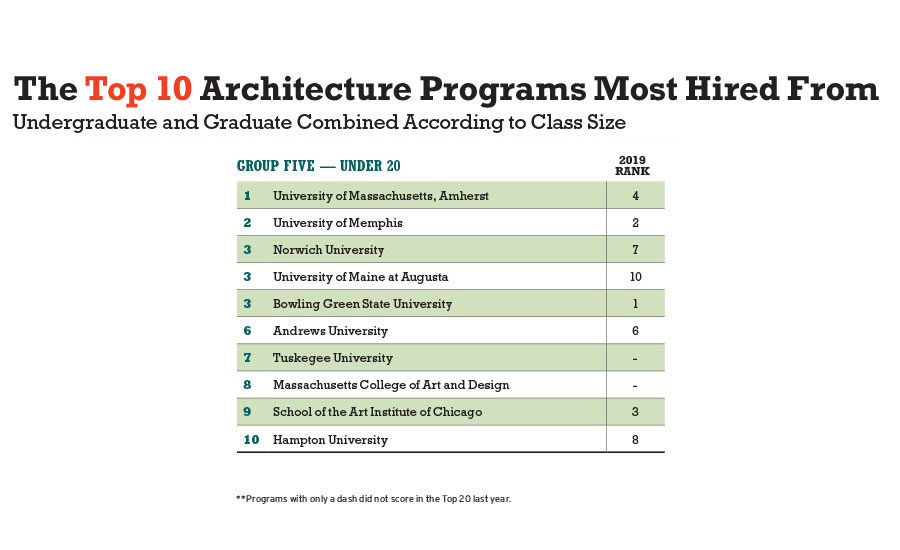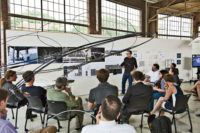Two years ago, after 19 years of conducting this ranking survey, DesignIntelligence (DI) moved from using the word “best” when ranking design schools (“Which programs are best preparing students for a future in the profession?”) to the term “most admired” (“What schools do you most admire for a combination of faculty, programs, culture, and student preparation for the profession?”). This was done to acknowledge the subjective nature of such rankings, in the absence of empirical evidence. Our research made clear that “best” is related to an individual respondent’s proclivities and therefore is not universally applicable.
Additional Content:
Jump to tables
While the DI survey always asked hiring professionals what programs were “best,” we have focused sharply over the past two years on what schools those professionals actually hire from the most. Professionals may say they admire one school over another, but that may not always have to do with the readiness and competence of the graduates. Often admiration is assigned to an institution based on a personal encounter, intellectual curiosity, or an inclination shaped through public relations. But when those same professionals put forth budgets, time frames, and performance expectations, the subjective is secondary to what is known, observable, and measurable. So we now ask a second primary question: “From which schools have you hired the greatest number of students (graduate and undergraduate combined) in the last five years?”
What the professional hiring managers from firms across the nation desire is the ability of graduates to hit the ground running when they begin work in the real world. That competence ranges from the fundamental knowledge of how buildings come together to the collaborative communication skills essential to design work. Our survey results indicated that 32 percent of professionals rank such fundamentals as inadequate among architecture graduates.
The wonder of new graduates is that they’re digital natives and comfortable with all types, uses, and expressions of information and design technology. But what’s so often missing is the human necessity of effective personal interaction. Conversational and written communication to defend and support detailed design decisions is critical to the future of the profession, yet so many don’t possess these basic skills.
We also survey students, and this year two unexpected results stood out from the 4,000-plus responses we received. First was the 5 percent drop in architecture undergraduate students wishing to go on to graduate school. The noted reasons were straightforward: accumulated debt and the marginal economic benefit that an advanced degree was thought to provide in gaining employment, as well as the drive to get out and get busy using their design skills.
The second standout was the answer to the following question: “If there were no barriers, what firm would you want to work for?” The No. 1 response overall was to be self-employed.
The lion’s share of students indicated that the work they do in the future must be purposeful, responsible, founded in defensible research, with a measurable impact. That sense of purpose continues to be a major drive in the generation entering the workforce: working for a wage is no longer enough motivation. A range of work is also critical: engaging various market types and solutions, and using a broader range of their skills. Traditional architecture/engineering and construction (AEC) practices were labeled out of date, stuck in old paradigms, irresponsible to communities and the environment, and motivated by financial considerations rather than the desire to do what is right.
As the leadership of DesignIntelligence travels the globe, these themes emerge on a consistent basis. Students, as well as young professionals, are demanding a different kind of industry. The future of AEC is on a radical path toward reinvention, led by the upcoming generations who have a new set of attitudes, values, and behaviors. Innovative ways of working, collaborating, leveraging knowledge through technology, and devising economic value are all challenging traditional ways and means across the design and construction industry. Lessons from other industries, such as tech, software/systems development, and aerospace are being directly applied to AEC, and the initial outcomes are indicating dramatic shifts in approaches, process, and fulfillment of building programs. For example, the use of Agile, Scrum, and other collaborative techniques in building design is spreading across the firms. As more students come to share this mindset regarding the future, their sheer momentum will alter the status quo. The hiring professionals in DI’s surveys may complain about inadequate training among today’s graduates, but the values and attitudes of this student generation will come to dominate and change the profession. As in Silicon Valley, where a growing number of software and systems designers are choosing to remain independent rather than work for big tech companies, so a similar trend is beginning with architecture graduates as well. Most of them are comfortable not only moving across various building technologies but are also mastering programming, development, and design of the user interface and user experience. Their ease of dealing with data, applying artificial intelligence, and employing machine learning only adds to their overall value in the workforce.
We at DesignIntelligence predict that the line between building design and technology design will continue to blur and that the economics of design will sharply improve as more architecture students enter the market as free agents. This will translate into higher earnings for cross-disciplinary talent, who will possess a broad orientation to problem-solving. We believe they will utterly alter the industry through redefining the values in design, with an accompanying enhanced reward system.
Institutions training architects will shift their educational programming to a radically more diverse landscape of learning. Architecture and design schools will become exponentially more effective when they kick down the walls between their programs and those of computer science, business, engineering, construction management and building sciences, social sciences, and other programs. When an architecture graduate who has been formally exposed to other disciplines enters the job market, his or her value will increase. These renaissance graduates will be the ones to radically transform the industry, either from within or by joining forces with the disruptors intent on driving waste and inefficiency out of the field.
The challenge for architecture firms will be in attracting these graduates and harnessing their range of skills. Traditional practices employing established methodologies and processes will need to rethink their day-to-day work and allow this new talent to bring fresh approaches.
The field of architecture is changing, and design education must change with it. Those institutions that do will lead, those that don’t will accelerate toward irrelevance.
Each year, DesignIntelligence (DI) conducts a survey of America’s top architecture schools, ranking undergraduate and graduate programs from the perspective of practitioners who hire graduates of those programs. The survey is sent, via email, to DI’s expansive network of hiring professionals, who tell us which schools they Most Admire and Most Hire From and how recent graduates are performing in 12 skill areas. The Most Hired ranking was launched two years ago and combines undergraduate and graduate programs from each school, taking into consideration the number of annual graduates. Those rankings are divided into five groups, from Group One with 100-plus graduates to Group Five with under 20 graduates. Most Admired rankings are determined separately for undergraduate and graduate programs. DI also reaches out to deans and chairs of architecture programs and asks them to distribute three surveys: to hiring professionals, to students, and one for themselves that asks about their programs and priorities. Lastly, DI surveys recent architecture graduates about the quality of the programs they studied in and how prepared they believe they are in key skill areas. This year, DI received nearly 12,000 responses from the three surveys in architecture (and also interior design and landscape programs). The responses from the hiring professionals only are used to determine the rankings of Most Admired and Most Hired From. DI validated the approximately 4,000 respondents from that group. The programs in the architecture survey must be accredited by the National Architectural Accrediting Board (NAAB).
The Top 10 Most Admired Architecture Undergraduate Programs
| 1 | Cornell University |
| 2 | Rhode Island School of Design |
| 3 | Rice University |
| 4 | Cooper Union |
| 5 | Syracuse University |
| 6 | Virginia Tech |
| 7 | Pratt Institute |
| 8 | California Polytechnic State University, San Luis Obispo |
| 9 | University of Texas, Austin |
| 10 | Southern California Institute of Architecture (SCI-Arc) |
Comparison of Previous Architecture Rankings: Undergraduate
| 2020 | 2019 | 2018 | 2017 | 2016 | 2015 | 2014 | 2013 | 2012 | |
| Cornell | 1 | 1 | 1 | 1 | 1 | 2 | 1 | 1 | 1 |
| Rhode Island School of Design | 2 | 6 | 10 | 7 | 6 | 7 | 10 | 7 | 6 |
| Rice University | 3 | 2 | 6 | 4 | 5 | 3 | 3 | 3 | 5 |
| Cooper Union | 4 | 5 | 15 | 12 | 14 | 13 | - | 16 | 14 |
| Syracuse University | 5 | 4 | 3 | 3 | 4 | 5 | 6 | 3 | 7 |
| Virginia Tech | 6 | 8 | 4 | 5 | 3 | 4 | 5 | 7 | 3 |
| Pratt Institute | 7 | 7 | 9 | 8 | 11 | 9 | 11 | 11 | 10 |
| Cal Poly, SLO | 8 | 3 | 2 | 2 | 2 | 2 | 1 | 5 | 4 |
| U.T., Austin | 9 | 10 | 7 | 6 | 7 | 6 | 4 | 6 | 2 |
| SCI-Arc | 10 | 9 | 8 | 10 | 12 | 8 | 9 | 2 | 7 |
**Programs with only a dash either did not score in the top 20 or did not have an accredited program at that time.
The Top 10 Most Admired Architecture Graduate Programs
| 1 | Harvard University |
| 2 | Columbia University |
| 3 | Massachusetts Institute of Technology (M.I.T.) |
| 4 | Yale University |
| 5 | Cornell University |
| 6 | Princeton University |
| 7 | Rice University |
| 8 | Rhode Island School of Design |
| 9 | University of Pennsylvania |
| 10 | University of California, Berkeley |
Comparison of Previous Architecture Rankings: Graduate
|
2019 | 2018 | 2017 | 2016 | 2015 | 2014 | 2013 | 2012 | ||
| Harvard University | 1 | 1 | 1 | 1 | 1 | 1 | 1 | 2 | 2 | |
| Columbia University | 2 | 2 | 2 | 4 | 4 | 2 | 3 | 2 | 3 | |
| M.I.T. | 3 | 3 | 5 | 3 | 5 | 4 | 4 | 4 | 6 | |
| Yale University | 4 | 5 | 4 | 5 | 3 | 3 | 2 | 3 | 2 | |
| Cornell University | 5 | 4 | 3 | 2 | 2 | 5 | 5 | 5 | 6 | |
| Princeton University | 6 | 6 | 22 | 16 | 12 | 13 | 13 | 15 | 19 | |
| Rice University | 7 | 7 | 16 | 9 | 8 | 7 | 5 | 15 | 14 | |
| Rhode Island School of Design | 8 | 19 | - | - | - | - | - | - | - | |
| University of Pennsylvania | 9 | 11 | - | - | - | - | - | - | - | |
| University of California, Berkeley | 10 | 8 | 8 | 6 | 6 | 10 | 9 | 7 | 14 |

















